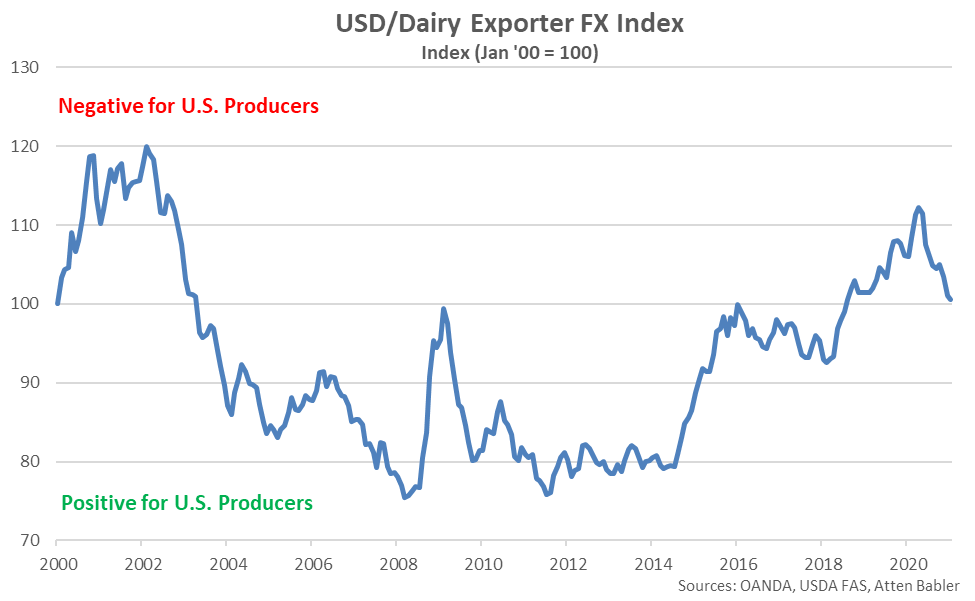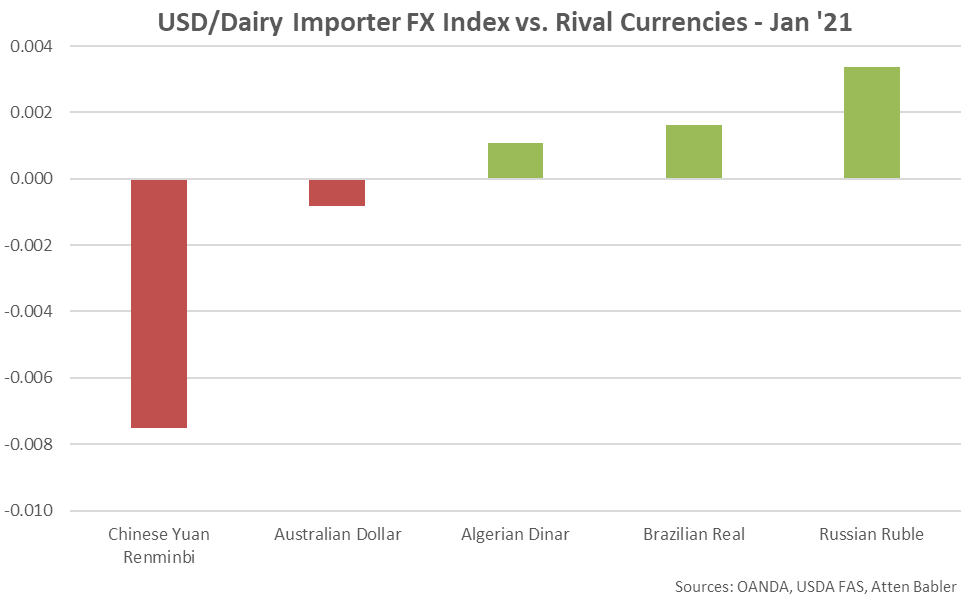Atten Babler Dairy FX Indices – Feb ’21
The Atten Babler Commodities Dairy Foreign Exchange (FX) Indices continued to weaken throughout Jan ’21. The USD/Dairy Exporter FX Index declined to a 30 month low level while the USD/Dairy Importer FX Index and USD/Domestic Dairy Importer FX Index declined to 11 and 32 month low levels, respectively, throughout the month.
Global Dairy Net Trade:
Major net dairy exporters are led by New Zealand, followed by the EU-28, the U.S., Australia and Argentina (represented in green in the chart below). Major net dairy importers are led by China, followed by Russia, Mexico, Japan, Indonesia, Algeria and the Philippines (represented in red in the chart below).

New Zealand accounts for over two fifths of the USD/Dairy Exporter FX Index, followed by the EU-28 at 29% and the United States at 17%. Australia and Argentina each account for between 5-10% of the index.

China accounts for a quarter of the USD/Dairy Importer FX Index while Russia accounts for a fifth. Mexico, Japan, Indonesia, Algeria and the Philippines each account for between 5-10% of the index.

USD/Dairy Exporter FX Index:
The USD/Dairy Exporter FX Index declined 0.6 points throughout Jan ’21, finishing at a 30 month low value of 100.5. The USD/Dairy Exporter FX Index has declined 5.5 points throughout the past six months but remains up 20.3 points since the beginning of 2014. A strong USD/Dairy Exporter FX Index reduces the competitiveness of U.S. dairy products relative to other exporting regions (represented in green in the Global Dairy Net Trade chart), ultimately resulting in less foreign demand for U.S. products, all other factors being equal. USD appreciation against the Argentine peso has accounted for the majority of the gains since the beginning of 2014.

Appreciation against the USD within the USD/Dairy Exporter FX Index during Jan ’21 was led by gains by the New Zealand dollar, followed by gains by the Australian dollar and euro. USD gains were exhibited against the Argentine peso.

USD/Dairy Importer FX Index:
The USD/Dairy Importer FX Index declined 0.1 points throughout Jan ’21, finishing at an 11 month low value of 137.6. The USD/Dairy Importer FX Index has declined 4.9 points throughout the past six months but remains up 37.0 points since the beginning of 2014. A strong USD/Dairy Importer FX Index results in less purchasing power for major dairy importing countries (represented in red in the Global Dairy Net Trade chart), making U.S. dairy products more expensive to import. USD appreciation against the Russian ruble has accounted for the majority of the gains since the beginning of 2014.

Appreciation against the USD within the USD/Dairy Importer FX Index during Jan ’21 was led by gains by the Chinese yuan renminbi, followed by gains by the Australian dollar. USD gains were exhibited against the Russian ruble, Brazilian real and Algerian dinar.

U.S. Dairy Export Destinations:
Major destinations for U.S. dairy exports are led by Mexico, followed by China, Canada, the Philippines, Indonesia, Japan and South Korea.

Mexico accounts for nearly a quarter of the USD/Domestic Dairy Importer FX Index, followed by China at 12%. Canada, the Philippines, Indonesia, Japan and South Korea each account for between 5-10% of the index.

USD/Domestic Dairy Importer FX Index:
The USD/Domestic Dairy Importer FX Index declined 0.3 points throughout Jan ’21, finishing at a 32 month low value of 133.6. The USD/Domestic Dairy Importer FX Index has declined 8.4 points throughout the past six months but remains up 26.8 points since the beginning of 2014. A strong USD/Domestic Dairy Importer FX Index results in less purchasing power for the traditional buyers of U.S. dairy products (represented in red in the U.S. Dairy Export Destinations chart), ultimately resulting in less foreign demand for U.S. products, all other factors being equal. USD appreciation against the Mexican peso has accounted for the majority of the gains since the beginning of 2014.

Appreciation against the USD within the USD/Domestic Dairy Importer FX Index during Jan ’21 was led by gains by the Chinese yuan renminbi, followed by gains by the Canadian dollar, Australian dollar and Indonesian rupiah. USD gains were exhibited against the Brazilian real.
